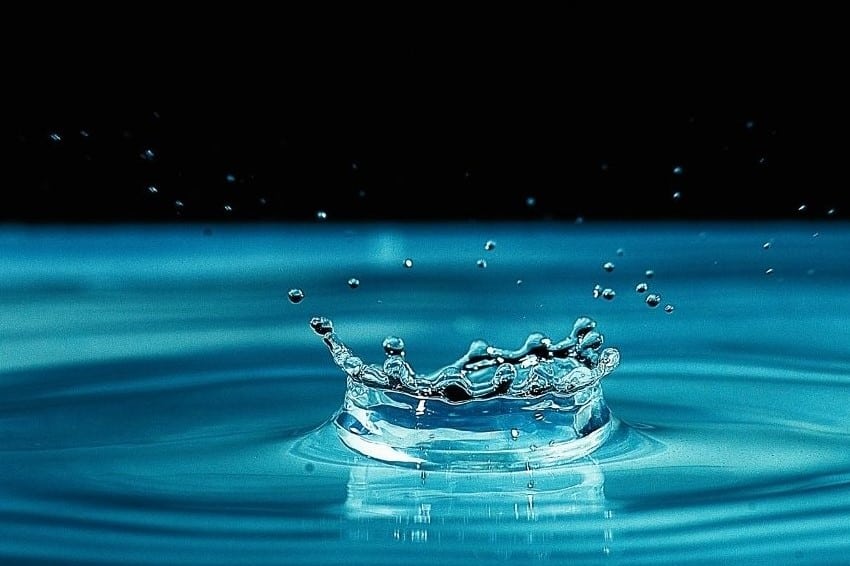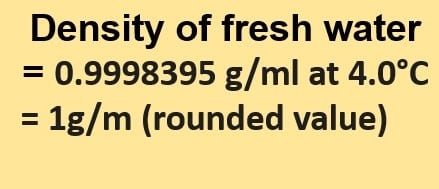Surface Tension is defined as “the quality of a liquid’s surface that permits it to resist an external force due to the cohesive nature of its molecules.” The surface tension of water at room temperature is about 72.8 millinewtons per meter (mN/m) or 72.8 dynes per centimeter (dyn/cm). This property is important in many natural and technological processes, such as capillary action, adhesion, and the formation of droplets and bubbles.

The surface tension of water is due to the hydrogen bonds between water molecules. These hydrogen bonds create a net inward force that causes the water molecules to pull together, minimizing the surface area and creating a strong surface tension.
The water molecules attract one another due to the water’s polar nature. The hydrogen ends in a water molecule are positive in comparison to the negative end of oxygen. This makes water molecules stick together. This is why there is surface tension and requires a certain amount of energy to break these intermolecular bonds.
Water’s surface tension can cause things that are denser than water to float, allowing organisms to walk on water.
There are two types of molecules in a sample of water. Those on the outside are referred to as exterior, while those on the inside are referred to as interior. The interior molecules are attracted to all the molecules around them, whereas the exterior molecules are only attracted to those on the surface and below the surface.
As a result, the energy state of the molecules on the inside is much lower than that of the molecules on the outside. Because of this, the exterior molecules try to maintain a small surface area, allowing more molecules to be in a lower energy state. This is what causes the surface tension of water.
Table of Contents
Concept of Surface Tension
Surface tension depends mainly upon the forces of attraction between the particles contained within a given liquid, as well as the gas, solid, or liquid in contact with it. Surface tension refers to forces that act in the plane of the surface and seek to lower its area. Surface tension is expressed as the amount of force exerted on the surface perpendicular to a line of unit length on this basis. The unit of measurement is then newtons per meter, which is equivalent to joules per square meter.
The molecules in a drop of water have a weak attraction to one another. At 20 °C (68 °F), water has a surface tension of 0.07275 joules per square meter.
Examples of Surface Tension
- Water striders and other little insects can walk on water because their weight does not penetrate the surface.
- The little needles may float on the surface of water despite being several times denser than water.
- Water surface tension bridges the pores of finely woven tent materials, making them rainproof.
- Disinfectants are usually low-surface tension solutions. This allows them to spread out and damage bacterial cell walls.
- Soaps and detergents assist clean garments by reducing water surface tension, allowing water to penetrate pores and dirty areas more easily.
- Washing with hot water is preferred because it has lower surface tension and is a better wetting agent.
- Water’s surface tension provides the required wall tension for the creation of bubbles. The propensity to reduce wall tension makes the bubbles round.
- Surface tension shapes liquid droplets. The surface layer’s cohesive forces tend to draw water droplets into a spherical shape.
Daily Life Significance of Surface Tension
- Surface tension allows insects and small animals to walk on water: The surface tension of water is strong enough to support the weight of small animals, such as water striders, allowing them to walk on the surface of the water.
- Capillary action: The surface tension of water also causes capillary action, which is the ability of liquids to flow in narrow spaces against gravity. This is important in the absorption of water by plants, and in the function of paper towels, which absorb water due to capillary action.
- Formation of droplets: Surface tension also causes water droplets to form, which is important in rain formation, fog, and mist.
- Adhesion: Surface tension causes water to stick to surfaces, which is important in many processes, such as washing dishes, where soap breaks the surface tension of water, allowing it to spread evenly over surfaces.
- Bubbles: The surface tension of water causes bubbles to form, which is important in carbonated drinks, where carbon dioxide gas is dissolved in water, and released as bubbles when the pressure is reduced.
Calculating the surface tension of water
To calculate the surface tension of water, you can use the capillary rise method or the drop weight method. Here’s a brief overview of both methods:
- Capillary Rise Method:
- You will need a capillary tube, a ruler, and a container of water.
- Fill the container with water and carefully insert the capillary tube into the water, ensuring it is completely submerged.
- Observe the height to which the water rises in the capillary tube. This height is known as the capillary rise.
- Measure the capillary rise using a ruler or a measuring device.
- Now, you can use the following formula to calculate the surface tension: Surface Tension = (2 * Density * g * Capillary Rise) / (Diameter of the Capillary Tube)
- Drop Weight Method:
- This method requires a fine needle, a balance, and a container of water.
- Dip the needle into the container of water, allowing it to wet completely.
- Carefully remove the needle from the water, allowing a small droplet to form at the tip.
- Place the needle on the balance and record its weight.
- Gently touch the droplet of water with a solid surface, such as a piece of wax paper, and record the weight of the needle again.
- The difference in the weights before and after the droplet touches the surface is due to the surface tension.
- Now, you can calculate the surface tension using the following formula: Surface Tension = (Weight of the Needle * g) / (2 * π * Radius of the Needle)
Solved Problem of Surface Tension
Problem: A small needle weighs 0.05 grams and is placed gently on the surface of a bowl of water. If the surface tension of water is 0.073 N/m, what is the weight of water lifted by the needle?
Solution:
The weight of the water lifted by the needle is equal to the force required to overcome the surface tension of the water and allow the needle to float on the surface. The surface tension force can be calculated using the formula F = T x l, where F is the force, T is the surface tension, and l is the length of the boundary.
In this case, the length of the boundary is equal to the circumference of the needle, which can be calculated using the formula C = 2πr, where C is the circumference and r is the radius of the needle. Assuming the needle is a perfect cylinder, the radius can be calculated using the formula r = d/2, where d is the diameter of the needle.
d = 0.5 mm (since the needle is small) r = 0.25 mm C = 2πr = 1.57 mm
Now, we can calculate the surface tension force using the formula F = T x C:
F = 0.073 N/m x 0.00157 m = 0.00011461 N
Finally, we can convert the force to weight using the formula W = F/g, where W is the weight, F is the force, and g is the acceleration due to gravity (9.81 m/s^2).
W = 0.00011461 N / 9.81 m/s^2 = 0.00001169 kg
Therefore, the weight of water lifted by the needle is approximately 0.00001169 kg, or 0.01169 grams.
Why water is a polar molecule?
Since the two hydrogen atoms are not uniformly distributed around the oxygen atom, water is a polar molecule. A water molecule has two poles due to the unequal distribution of electrons among the atoms and the asymmetrical form of the molecule: a positive charge on the hydrogen pole (side) and a negative charge on the oxygen pole (side) (side).
Please refer to the full article “Why water is a polar molecule?”.
Summary
- The surface tension of water is 0.07275 joule per square meter at 20 °C (68 °F).
- A water sample contains two types of molecules. The outside is called the “exterior,” and the inside is called the interior.
- A surface molecule is attracted to all molecules around it, whereas an interior molecule is only attracted to those nearby.
- As a result, the inside molecules have a lower energy state than the outside molecules.
- So the outer molecules try to keep their surface area small, allowing more molecules to be in a lower energy state. This causes water surface tension.
More Interesting Topics
How Much Does a Gallon of Water Weigh?
How Many Water Bottles is a Gallon| Examples
Density of Water in g/ml-Accurate Value
What is Fresh Water?
Why Does Oil Float on Water?
How many hydrogen atoms are in a molecule of water?
- BCl3 Lewis Structure in four simple steps - November 1, 2023
- PH3 Lewis Structure in four simple steps - October 8, 2023
- PF3 Lewis structure in four simple steps - September 24, 2023



